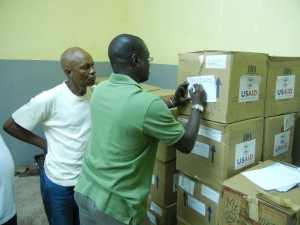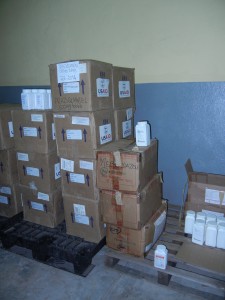Building capacity: On-the-job training improves storage of NTD medicines in Sierra Leone
September 10th, 2013
By Guest Bloggers: Paula Nersesian and David Paprocki, John Snow, Inc.
Procuring and efficiently delivering preventative medicine for neglected tropical diseases (NTD) to thousands of geographically dispersed communities is a challenging undertaking, at best. It takes teamwork and open communication among the many players involved in the country’s drug supply chain team.

NTD warehouse manager and supply chain consultant label medicines in Sierra Leone. Photo: Paula Nersesian, JSI
However in some countries, since the regional drug storage facilities that house NTD medicines tend to be far away from the national storage center, warehouse managers may only have a chance to talk to each other once in a while, at best. When communication is lacking, professional and personal relationships aren’t developed and vital information may not be shared.
This was the situation in Sierra Leone, where NTD medicines are stored at a facility several hours drive from the national central medical store in Freetown. Since the NTD drug facility manager was far from his colleagues who manage health products, he was isolated and was unable to observe, discuss, and learn from the storage practices used by colleagues.
Recognizing the need to reduce warehouse inefficiencies and drug waste, Sierra Leone’s national NTD program requested technical assistance from the END in Africa team. After the request was approved, health supply chain consultants from END in Africa partner John Snow, Inc. (JSI) made two visits to Sierra Leone and provided the NTD warehouse manager with on-the-job training (OJT) to build his skills in:
- Applying standard storage procedures for health products.
- Identifying and applying logistics management information.
During their first visit in February 2012, the JSI consultants conducted an NTD supply chain and drug management assessment. After touring the NTD warehouse and observing its operations, they recommended reorganizing the warehouse and adopting accepted international standards for storing health products.

Boxes of NTD medicines atop wooden pallets, protecting them from contamination and dirt from the floor. Photo: Paula Nersesian, JSI
While there are many reasons for adopting internationally accepted storage practices for health products at NTD drug warehouses, perhaps the most important is to help ensure that the drugs don’t become ineffective before their listed expiration date. This is important because using ineffective medicines to treat people for NTDs during mass drug administration (MDA) campaigns can have disastrous consequences.
People who receive treatments with ineffective medicines are still at risk for contracting NTDs. So, imagine what would happen if they became sick after taking the medicines. Not only they would likely start to mistrust the drugs and the NTD program, they may also stop taking the treatments altogether, as well as influence others to do the same. Such a scenario could stall or even reverse any progress that had made toward eliminating NTDs in their communities.
Adopting internationally accepted storage practices for health products precludes such a scenario from occurring by employing proven optimal drug management procedures for NTD medicine warehouses. Countries that adopt these practices benefit from greatly reduced drug waste, fewer stock-outs, and most importantly, a reliable drug supply that doesn’t lose its potency prematurely.
However, since even the best recommendations are of limited use if they’re not put into practice, it’s important to pair them with training. In the case of the NTD warehouse in Sierra Leone, the JSI consultants opted to use on-the-job training (OJT) for capacity building for several reasons: only one person (the warehouse manager) required training; and the program needed the manager to be present every day (eliminating the option of sending him to outside training).
OJT has several advantages beyond simple convenience, however. First, learning new skills in their own work environment gives people the opportunity to apply those new skills immediately in a real-world setting. In Sierra Leone, the JSI supply chain consultants reviewed the country’s NTD warehouse logistics forms with the manager and asked him to practice filling them out. This gave him the chance to ask questions and get immediate clarification and feedback.
Second, OJT enables trainers and trainees to adapt the workplace to make it easier for trainees to use their new skills after the training ends. In Sierra Leone, the consultants showed the NTD warehouse manager how to use a validated storage checklist (from the USAID DELIVER Project) to review key storage requirements for health products, and then adapted the checklist according to the specific needs of the manager. They also affixed a laminated poster in the warehouse to help the manager remember the key steps for storing health products.

Poster on proper storage guidelines for health commodities serves as a reminder for NTD warehouse staff. Credit: USAID | DELIVER PROJECT, 2008
Guidelines for proper storage of health commodities
Finally, providing on-site capacity building creates the best opportunity to resolve environmental problems. For example, at the NTD warehouse, the manager and consultants:
- used pallets to get boxes of NTD medicines off the floor and away from the wall;
- created labels listing the name and number of tablets per bottle for each medicine;
- moved obstacles out of walkways and away from exits; and
- separated non-medical items from NTD medicines to improve organization and use of space.
Although it may not be possible to resolve every environmental problem on the spot, they are at least more likely to be noticed when training occurs in the workplace. Once identified, problems can be put on a follow-up list for later action. For example in Sierra Leone, the JSI consultants noticed that the NTD warehouse didn’t have a functional fire extinguisher, prompting them to advise the manager to procure one and help him find the best location to install it once it had arrived.
Regardless of whether capacity building is done through OJT or other forms of training, the most effective learning environment is encouraging, non-threatening, and experiential. When supervisors establish a safe training environment for their staff, work issues can be discussed openly, problems can be identified more easily, and new competencies can be developed more quickly.
The Sierra Leone example shows just how effective such a training environment can be. Over a year after the OJT, the JSI consultants visited the facility a second time and found that the information they had provided during the first visit had been internalized by the warehouse manager and that the changes they’d put in place together in 2012, were still in effect.

